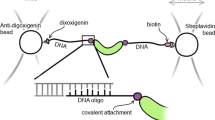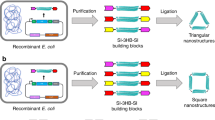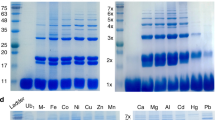Abstract
Single-molecule methods such as force spectroscopy give experimental access to the mechanical properties of protein molecules. So far, owing to the limitations of recombinant construction of polyproteins, experimental access has been limited to mostly the N-to-C terminal direction of force application. This protocol gives a fast and simple alternative to current recombinant strategies for preparing polyproteins. We describe in detail the method to construct polyproteins with precisely controlled linkage topologies, based on the pairwise introduction of cysteines into protein structure and subsequent polymerization in solution. Stretching such constructed polyproteins in an atomic force microscope allows mechanical force application to a single protein structure via two precisely controlled amino acid positions in the functional three-dimensional protein structure. The capability for site-directed force application can provide valuable information about both protein structure and directional protein mechanics. This protocol should be applicable to almost any protein that can be point mutated. Given correct setup of all necessary reagents, this protocol can be accomplished in fewer than 10 d.
This is a preview of subscription content, access via your institution
Access options
Subscribe to this journal
Receive 12 print issues and online access
$259.00 per year
only $21.58 per issue
Buy this article
- Purchase on Springer Link
- Instant access to full article PDF
Prices may be subject to local taxes which are calculated during checkout


Similar content being viewed by others
References
Bustamante, C., Chemla, Y.R., Forde, N.R. & Izhaky, D. Mechanical processes in biochemistry. Annu. Rev. Biochem. 73, 705–748 (2004).
Rief, M., Gautel, M., Oesterhelt, F., Fernandez, J.M. & Gaub, H.E. Reversible unfolding of individual titin immunoglobulin domains by AFM. Science 276, 1109–1112 (1997).
Li, H., Oberhauser, A.F., Fowler, S.B., Clarke, J. & Fernandez, J.M. Atomic force microscopy reveals the mechanical design of a modular protein. Proc. Natl. Acad. Sci. USA 97, 6527–6531 (2000).
Carrion-Vazquez, M. et al. Mechanical design of proteins studied by single-molecule force spectroscopy and protein engineering. Prog. Biophys. Mol. Biol. 74, 63–91 (2000).
Yang, G. et al. Solid-state synthesis and mechanical unfolding of polymers of T4 lysozyme. Proc. Natl. Acad. Sci. USA 97, 139–144 (2000).
Dietz, H. & Rief, M. Protein structure by mechanical triangulation. Proc. Natl. Acad. Sci. USA 103, 1244–1247 (2006).
Rounsevell, R.W., Steward, A. & Clarke, J. Biophysical investigations of engineered polyproteins: implications for force data. Biophys. J. 88, 2022–2029 (2005).
Li, L., Huang, H.H., Badilla, C.L. & Fernandez, J.M. Mechanical unfolding intermediates observed by single-molecule force spectroscopy in a fibronectin type III module. J. Mol. Biol. 345, 817–826 (2005).
Dietz, H. & Rief, M. Exploring the energy landscape of GFP by single-molecule mechanical experiments. Proc. Natl. Acad. Sci. USA 101, 16192–16197 (2004).
Fisher, T.E., Marszalek, P.E. & Fernandez, J.M. Stretching single molecules into novel conformations using the atomic force microscope. Nat. Struct. Biol. 7, 719–724 (2000).
Clausen-Schaumann, H., Seitz, M., Krautbauer, R. & Gaub, H.E. Force spectroscopy with single bio-molecules. Curr. Opin. Chem. Biol. 4, 524–530 (2000).
Zinober, R.C. et al. Mechanically unfolding proteins: the effect of unfolding history and the supramolecular scaffold. Protein Sci. 11, 2759–2765 (2002).
Acknowledgements
This work has been supported by an SFB413 grant of the Deutsche Forschungsgemeinschaft.
Author information
Authors and Affiliations
Contributions
H.D. developed the protocol, performed and designed research, analyzed the data and wrote the manuscript. M.B. performed size-exclusion chromatography and gel electrophoresis experiments and analyzed the data from these experiments. F.B. performed supporting experiments on GFP polyproteins. M.S., T.B., J.P.J. helped to refine the protocol. M.R. designed research and wrote the manuscript. All authors commented on the manuscript.
Corresponding author
Ethics declarations
Competing interests
The authors declare no competing financial interests.
Rights and permissions
About this article
Cite this article
Dietz, H., Bertz, M., Schlierf, M. et al. Cysteine engineering of polyproteins for single-molecule force spectroscopy. Nat Protoc 1, 80–84 (2006). https://doi.org/10.1038/nprot.2006.12
Published:
Issue Date:
DOI: https://doi.org/10.1038/nprot.2006.12
This article is cited by
-
Detection of weak non-covalent cation-π interactions in NGAL by single-molecule force spectroscopy
Nano Research (2022)
-
Enzymatic biosynthesis and immobilization of polyprotein verified at the single-molecule level
Nature Communications (2019)
-
A simple two-state protein unfolds mechanically via multiple heterogeneous pathways at single-molecule resolution
Nature Communications (2016)
-
Action of the Hsp70 chaperone system observed with single proteins
Nature Communications (2015)
-
Immune atomic force microscopy of prestin-transfected CHO cells using quantum dots
Pflügers Archiv - European Journal of Physiology (2009)
Comments
By submitting a comment you agree to abide by our Terms and Community Guidelines. If you find something abusive or that does not comply with our terms or guidelines please flag it as inappropriate.



